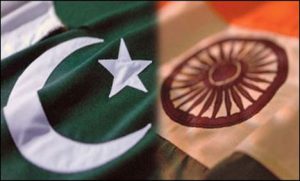Newspaper Article 15/09/2015
Pakistan and India relations have witnessed a serious deadlock over the collapse of peace talks even before they have started. The decision to pull out was taken by Pakistan after India’s ultimatum to stick to terrorism related agenda. Last year in August, foreign secretary level meeting was cancelled in pretext of Pakistan’s High Commissioner meeting with Kashmiri Leaders at New Delhi. According to media reports, around 91 ceasefire violations had taken place since Sharif and Modi Ufa meeting.
Historically, the composite dialogue between Pakistan and India started when President Zia-ul-Haq’s visit to India in December 1985, on his way back from SAARC Summit at Malay. At that time, Indian PM Rajeev Gandhi and President Zia decided to start a dialogue process between the two countries. They agreed upon four-pronged dialogue process to discuss four subjects in the dialogue process which were: 1) Siachin; 2) Sir Creek; 3) Commercial relations; 4) Issues related to terrorism/ immigration and people to people contact. Four committees were established to work on these issues. These committees were headed by different secretaries to deal with the relevant issues. During foreign secretary meetings, gradual progress was made in these areas.
The Siachin and Sir Creek were settled and only there implementation was left at that time. Similarly, commercial relations had improved and trade had expanded. The people to people contact had increased. However, nothing was done on Kashmir issue. So later in 1990’s, at Foreign Secretary meeting when the Kashmir issue was highlighted India was adamant to state that there was nothing to discuss about Kashmir except about the illegal occupation of Indian territory by Pakistan. This resulted in frostiness of relations between the two states and the dialogue process skeptically stopped.
In 1997, at Male SAARC Summit, Indian PM I.K. Gujral and Pakistani PM Nawaz Sharif decided to restart the dialogue process. This time eight issues were mentioned to be discussed under the composite dialogue process which included: 1) Peace and Security including confidence building measures (CBMs); 2) Jammu and Kashmir (J&K); 3) Siachen; 4) Wullar Barrage/Tulbul Navigation Project; 5) Sir Creek; 6) Economic and Commercial Cooperation; 7) Terrorism and Drug Trafficking; and, 8) Promotion of Friendly Exchanges in various fields. However, the dialogue process could not make progress due to 1998 nuclear tests and the Kargil conflict. The Lahore declaration and Agra Summit could not achieve the desired results. Both initiatives failed to resolve the contentious issues and improve the bilateral relations between the two countries.
In 2003, Musharraf took bold initiative and there was a famous Vajpayee-Musharraf golden handshake. This ultimately led to a bilateral meeting at the sideline of SAARC Summit, held at Islamabad in 2004. In that meeting, a declaration was made that Pakistan territory would not be used by any terrorist in the light of India’s concern of cross border terrorism emanating from Pakistan. Therefore, in 2004, the dialogue process between India and Pakistan resumed in the form of the composite dialogue. The discussions also started on the Kashmir issue at the foreign secretary level. There was normalization of relations, development in peace and security and several CBM’s were made that included starting of bus services from Sri Nagar-Muzaffarabad and facilitation in cross border permits, etc.
In order to resolve the Kashmir issue, Musharraf proposed a new format to discuss the Kashmir issue. He gave a four point agenda that included; 1) softening of LoC; 2) self-governance/autonomy but not total independence of Kashmir; 3) demilitarization of borders; and 4) joint management and supervision by both the states. This proposal was discussed through the back channel and the subjects were kept away from the media and the public until a final agreement could be reached. But nothing substantial could be achieved. Finally, the whole peace process came to a standstill owing to Samjhuta Express Bombings of 2007 and Mumbai attacks of 2008.
Similarly, the committee on peace and security could not achieve much progress except the development of few CBM’s like prior notifications of exercises, regular hot talk between DGMO’s and military manouevers, etc. Therefore, the committee on peace and security had not achieved much under the composite dialogue because India had its own trajectory and Pakistan had its own defence and security concerns. People to people contact did not proceed well after Mumbai attacks as the visa issues could not be resolved. Similarly in trade sector, Pakistan-India did not progress due to tariffs and strict trade policies. In fact, India has higher trade volumes with other regional countries like China, Nepal, Sri-Lanka and Bangladesh as compared to Pakistan. The water issues particularly building of dams by India, an open violation of Indus Waters Treaty (IWT) in Jammu and Kashmir, is another threat to Pakistan’s economy and survival. The menace of terrorism, Indian false allegations against Pakistan regarding safety of its nuclear assets and accusing Pakistan behind militancy in Kashmir and for providing safe havens to terrorists have increased the trust deficit between the two states.
So the overall analysis of composite dialogue shows that it was a zero sum game and both sides have not achieved desired goals and political objectives under the composite dialogue. There are no future prospects of composite dialogue with India. India’s adamant policies towards Pakistan, perpetual violation of working boundary and cross-border, strong opposition to CPEC, involvement in Balochistan insurgency and irregular hawkish statements from political leadership have spoiled the overall peace process. The RSS anti-Muslims ideology, propagation of Hindutva mindset have closed windows for further dialogue or peace talks with India in the near future.
The article was carried by Pakistan Observer on September 3,2015 http://pakobserver.net/detailnews.asp?id=272153 and by CSS Forum http://csscurrentaffairs.pk/analysis-pak-india-composite-dialogue-aymen-ijaz/
Disclaimer Views expressed are of the writer and are not necessarily reflective of IPRI policy.


